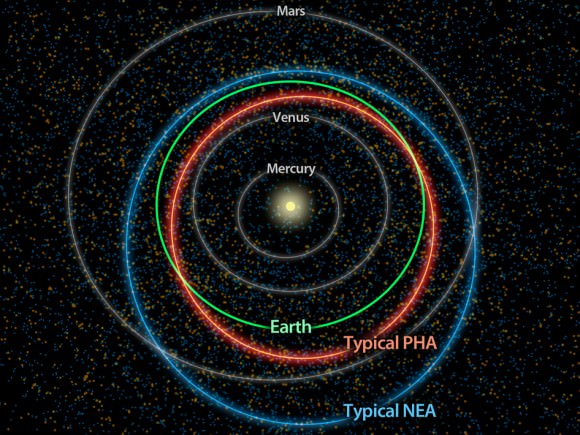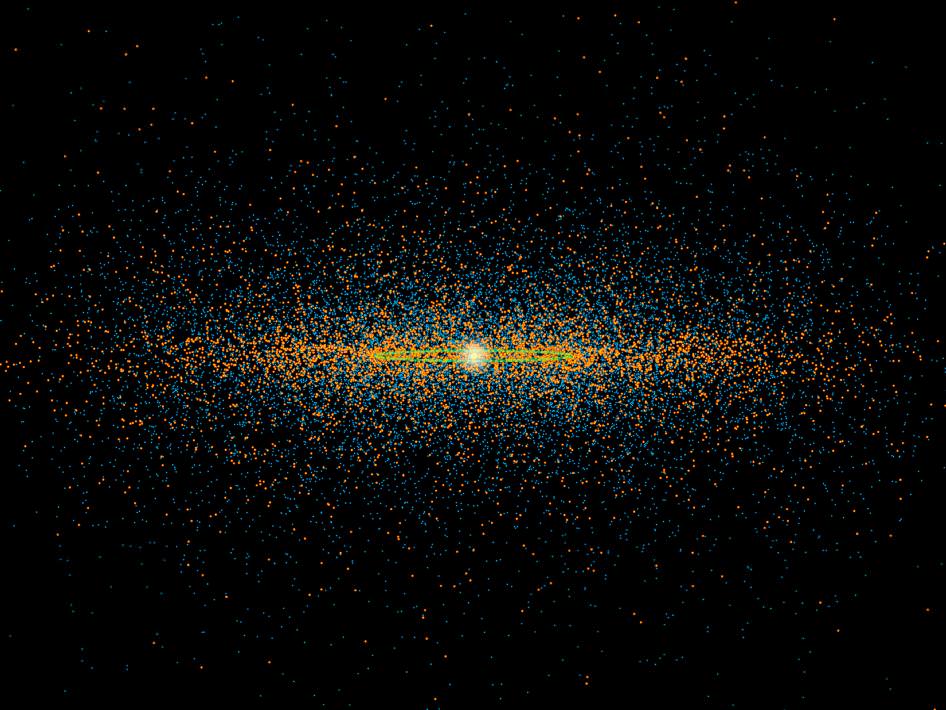[/caption]
There are now 4,700 asteroids out there — plus or minus 1,500 – that are considered Potentially Hazardous Asteroids (PHAs). This is the latest and best assessment yet of our solar system’s population of Near Earth Objects that have the potential to make close Earth approaches. The new results come from data obtained from the asteroid-hunting portion of the now-hibernating WISE mission, called NEOWISE.
And no, these asteroids don’t really want to harm you, but they might. “Potentially Hazardous” does not mean an asteroid will impact the Earth; it only means there is a possibility for such a threat. But only by monitoring these PHAs and updating their orbits with new observations can astronomers better predict the close-approach statistics and their Earth-impact threat. So let’s keep looking.
While previous estimates of PHAs predicted similar numbers, they were rough approximations. NEOWISE has generated a more dependable estimate of the objects’ total numbers and sizes.
“The NEOWISE analysis shows us we’ve made a good start at finding those objects that truly represent an impact hazard to Earth,” said Lindley Johnson, program executive for the NASA’s Near-Earth Object Observation Program. “But we’ve many more to find, and it will take a concerted effort during the next couple of decades to find all of them that could do serious damage or be a mission destination in the future.”
As of today, May 16, 2012, 8,874 Near-Earth objects have been discovered, with about 843 of these NEOs being asteroids with a diameter of approximately 1 kilometer or larger. 1,320 of these discovered NEOs have been classified as PHAs.
PHAs are a subset of the larger group of Near-Earth asteroids, those which have the closest orbits to Earth’s, coming within 8 million kilometers (five million miles) and they are big enough to survive passing through Earth’s atmosphere and cause damage on a regional, or greater, scale.
The WISE spacecraft did not identify and count each of these asteroids. Instead, scientists sampled 107 PHAs to make predictions about the entire population as a whole. Astronomers estimate that so far 20 to 30 percent of these objects have actually been found and cataloged. Last year, the WISE team announced they found there are likely less asteroids that are larger than 100 meters (mid-range sized asteroids) and estimate that with all the surveys combined, 93% of the asteroids larger than 1 kilometer have been found.

The new analysis also suggests that about twice as many PHAs as previously thought are likely to reside in “lower-inclination” orbits, which are more aligned with the plane of Earth’s orbit. These asteroids would be more likely to encounter Earth and therefore be easier to reach. So the new results suggest more near-Earth objects might be available for future robotic or human missions.
See our recent article on computing which asteroids might have the most potential for asteroid mining.
In addition, these lower-inclination objects appear to be somewhat brighter and smaller than the other near-Earth asteroids that spend more time far away from Earth. A possible explanation is that many of the PHAs may have originated from a collision between two asteroids in the main belt lying between Mars and Jupiter. A larger body with a low-inclination orbit may have broken up in the main belt, causing some of the fragments to drift into orbits closer to Earth and eventually become PHAs.
Brighter asteroids may be either stony — like granite — or metallic. This type of information is important in assessing the space rocks’ potential hazards to Earth. The composition of the bodies would affect how quickly they might burn up in our atmosphere if an encounter were to take place.
“NASA’s NEOWISE project, which wasn’t originally planned as part of WISE, has turned out to be a huge bonus,” said Amy Mainzer, NEOWISE principal investigator. “Everything we can learn about these objects helps us understand their origins and fate. Our team was surprised to find the overabundance of low-inclination PHAs. Because they will tend to make more close approaches to Earth, these targets can provide the best opportunities for the next generation of human and robotic exploration.”
The WISE spacecraft scanned the sky twice in infrared light before entering hibernation mode in early 2011. It catalogued hundreds of millions of objects, including super-luminous galaxies, stellar nurseries and closer-to-home asteroids. The NEOWISE project snapped images of about 600 near-Earth asteroids, about 135 of which were new discoveries. Because the telescope detected the infrared light, or heat, of asteroids, it was able to pick up both light and dark objects, resulting in a more representative look at the entire population. The infrared data allowed astronomers to make good measurements of the asteroids’ diameters and when combined with visible light observations, how much sunlight they reflect.
For more information, see NASA’s Near Earth Object Program website, and the WISE website.
Source: NASA
This video is from September of 2011, discussing the previous findings of the NEOWISE project:


Potentially Hazardous Asteroids 1320
http://www.minorplanetcenter.net/
Thanks, Charles!
I love the title!
I agree. It made me laugh. And really how can we be sure they DON’T want to kill us? Has anybody ever asked them?
Why aren’t the Federal Police doing anything about this!?!?!?!
my buddy’s mom makes $72 hourly on the internet. She has been without work for 9 months but last month her check was $12657 just working on the internet for a few hours. Go to this web site and read more ?????? http://Makecash11.blogspot.com
Spammer Please Flag !!!!dasdfadsSpammer Please Flag !!!!Spammer Please Flag !!!!Spammer Please Flag !!!!Spammer Please Flag !!!!
I think we need to attack these PHAs before they attack us.
Chuck Norris. That’s the answer.
Could someone tell me when these 4700 astroids will hit earth? one year? 2 years from now? Many thanks.